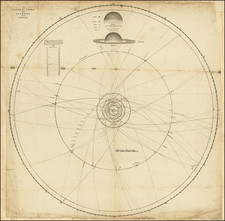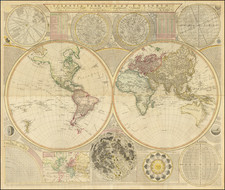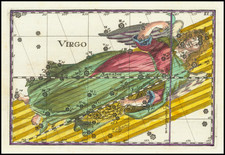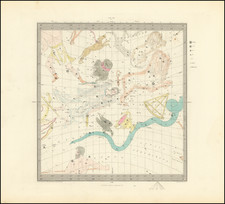The Earliest Surviving Example of Jan Stampioen's Star Chart and Celestial Calculator
Nice example of Vooght's rare celestial chart, published by Johannes Van Keulen in Amsterdam for Claes Jansz Vooght.
Vooght's chart illustrates the stars visible from 52 degrees latitude in a polar equidistant projection. Though designed for use at a latitude of 52 degrees, the text suggests it remains accurate from 49 to 55 degrees, which would allow its use through much of northern Europe.
The circular border around the image of the heavens includes scales with technical data.
The chart illustrates 53 constellations, numbered by quadrant, with a key in Dutch, along with French and English translations in the panels at the top and bottom of the image.
At the right, the instructional text describes six "proposals" (the first explaining the different scales, etc., and the others giving examples of the use of the chart).
The chart is based upon Jan Jansz. Stampioen's 1664 chart, which had been published in Amsterdam by Hendrik Doncker, with text by Dirk Rembrandtsz. Van Nierop. However, neither the 1664 edition, nor the later 1684 version (also apparently published by Doncker) are known to survive.
The chart would have been issued between 1680 and August 28, 1696, when Johannes Loots advertised what would be the second edition of Vooght's chart, with instructional text by Simon van de Moolen.
The chart was also apparently issued in some copies of Van Keulen's atlases and survives without the paper ring in a single example of the 1708-09 'Zee-Atlas' (part I) at the Dutch Maritime Museum in Amsterdam. Thiele reported a copy of an earlier atlas (1681-1686) which could not be located by later scholars.
Jan Jansz de Jonge Stampioen
Jan Jansz de Jonge Stampioen (1610 -1653) was a Dutch mathematician famous for his published work on spherical trigonometry. In 1638, he moved to The Hague to become tutor of William II, Prince of Orange. In 1644 he was employed to tutor Christiaan Huygens in mathematics.
Stampioen's father, Jan Stampioen the Elder, was a land surveyor who made astronomical instruments. It is likely his father's Coelestum Planum of 1619 was the inspiration for Stampioen's celestial model.
Rarity
The chart with volvelle is extremely rare, with only 2 institutional examples located (Boerhaave Museum in Leiden and the Adler Planetarium in Chicago).
The later 1722 edition was offered for sale by Asher & Company in their catalog 40, Item 80 for 35,000 Euros.









![[ Orion / Canis Minor / Lepus ]](https://storage.googleapis.com/raremaps/img/small/102620.jpg)




![[Ion Powered Spacecraft Traveling To Mars]](https://storage.googleapis.com/raremaps/img/small/83629.jpg)